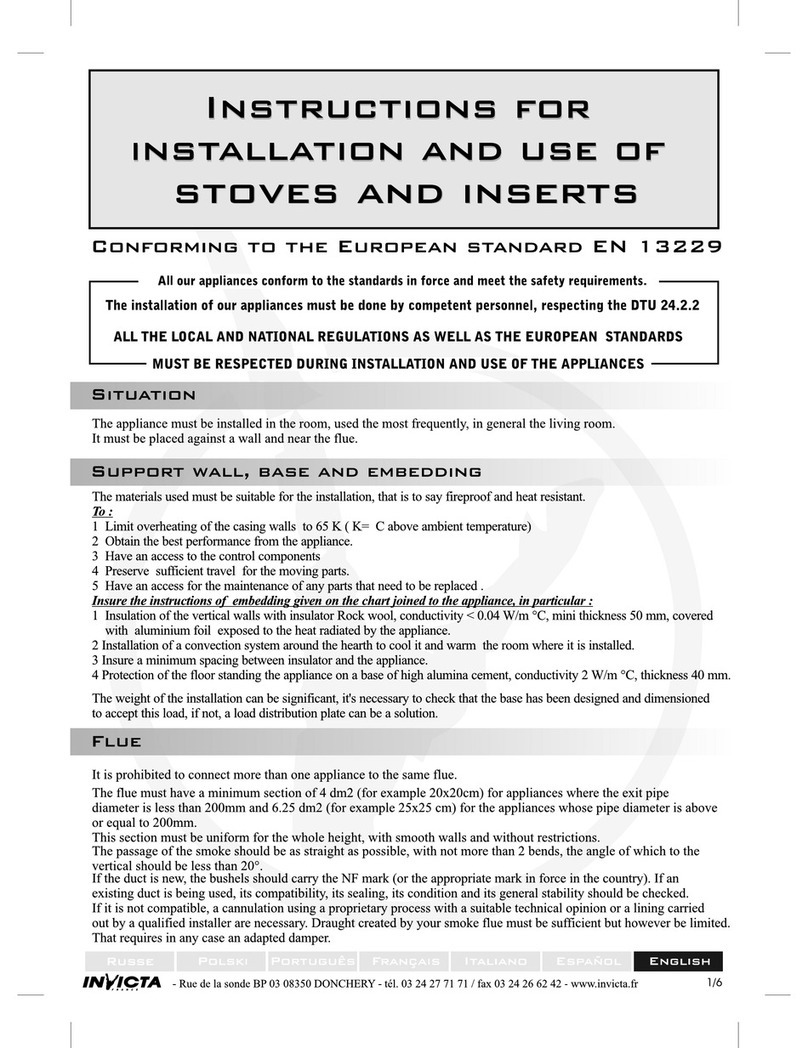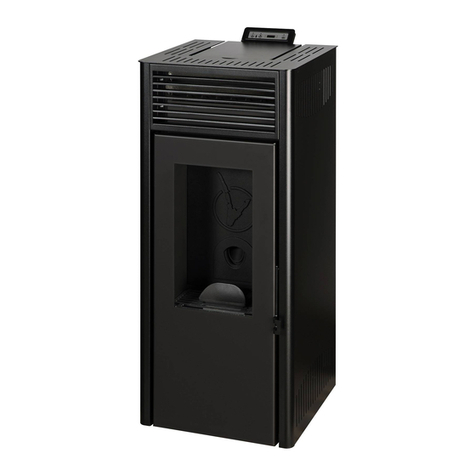
TIPI
STOVE
reference 6153 44
NB le 15/02/2011 Page 3sur 9
INSTRUCTIONS FOR INSTALLATION
To limit the warming of the walls that forming the chimney surround, at 65K (K= Celsius above ambient temperature), and obtain a
smooth functioning, it’s necessary to respect the disposition principal of below schemes.
If the adjoining sides are in non-combustible material and do not damage under heat effect (temperature of the wall can reach 200°C), those
dimensions can be reduced to 15 cm.
USING ADVICES WITH CLOSED DOORS
:
•Precautions when commissioning.
Put the deflector in place (see instructions and scheme page 7)
-During the first using, a paint smell will get out of the appliance : ventilate the room to limit this inconvenience or make a
first use outside the house.
Ignition :
Place crumpled paper on the grid and dry splint (small branches well dry or fine-chopped wood). Set fire to the paper, close the door,
and open entirely the air control. When it’s well flamed, you can load your appliance. It’s recommended, during first hours, to do a moderate fire,
to let a normal dilation of the whole appliance
Functioning intermittent and continuous :
The ‘Intermittent’ functioning need a loading every 45 minutes with small quantity of wood. It’s necessary to privilege this functioning mode
particularly performant and eco-aware.
The appliance can also assure a ‘continous’ functioning when intermittence confines cannot be respected, or when a reduced output is wanted.
In that case, the full load can be obtained during 3 hours, and, at moderate pace and low power, 10 hours is possible.
Nominal heat output
: in ’Intermittent’, it’s obtained with a 12 Pa draught, with a 3 kgs loading of wood, 2 half-logs of hard wood, renewed
every 45 min, with a bed of glowing embers (3cm), with ‘normal rate’ regulating (figure 1 page 7). In ‘’Continuous’’ loading is led to 6-8 kg in
3 logs, renewed every 3 hours.
A lower activity can happen due to unfavourable evolution of combustion, an inappropriate geometry of logs, too hard wood using or too wet.
Those slowing down phenomenons, which are not exceptional or totally predictable, resulting into a decrease of the blanket of flames (the
combustible forms a vault and is not in contact with braise anymore), the progressive decrease of the braise reserve and the hearth cooling.
They are accompanied by a power drop, and performance decrease.
To avoid this : carefully open the door of the hearth/stove, reorganize the load on the ember bed, picking and move the combustible with a
poker, watching out for braises falling over the hearth, then close again the door. The activity regains immediately after closing the door.
•Slow combustion of 10 hours :
it’s obtained under a 6Pa draught with a 6-8 kgs load, constituted of 1 or 2 hard logs non chopped,
favouring high diameter (more than 16 cm, 6.3 “), and closing completely the pace register. Complete beforehand a reduced rate of flow by
closing the air register, to then load on a barely glowing ember bed / braises.
mm
Rear
Lateral
wall
OVE INSTALLATION TOP VIEW





























